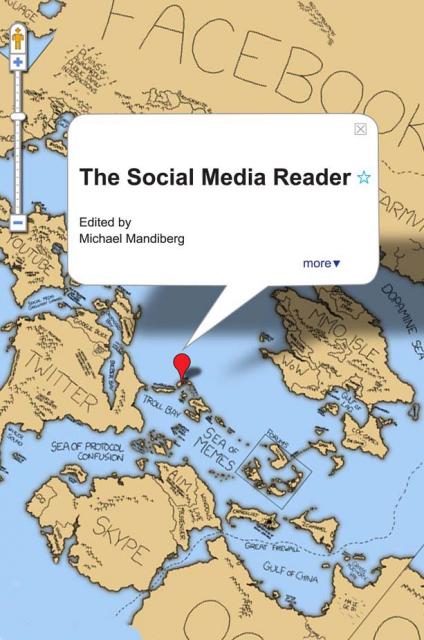Introduction
My first encounter with this comprehensive collection of essays took place in a graduate seminar offered in Fall 2013 in the Arizona State University Department of English, taught by Alice Daer, entitled Digital Literacies and Social Media. At a time in which gender and digital culture is at the forefront of many scholars' minds in this area (indeed, as Daer herself experienced recent Gamergate attacks targeted at advocates of women in gaming culture), it is important to note that this collection of essays, with the exception of the work of danah boyd, presents a recent snapshot of social media in which women who study the Internet—as well as women on the Internet—are entirely left out. That being said, The Social Media Reader was offered to provide a broad overview of current social media scholarship, and indeed, as editor Michael Mandiberg (2012) explained in his own introduction to the text, "[t]he goal of this book is to bring examples [of social media scholarship] from the multiple disciplines, perspectives, and agendas into one space" (p. 4). This collection includes essays previously published over the last ten years (or essays from other forms of communication such as lectures, blogs, and white papers) from a diverse array of positions within the world of social media, including communication, media studies, English studies, journalism, and software and other related industries. The book is designed to provide theoretical terminology for social media scholarship and to illuminate how different disciplinary approaches create and employ differing terminology for similar phenomena. By bringing these approaches and their terminology together, it is possible to uncover theoretical continuities.
Although several of the essays are likely familiar to Kairos readers, the chapter summaries in this review serve as a re-familiarization of the material and how these theoretical continuities across chapters emerge as a result of section delineations and essay selection. These summaries also show how this essay collection provides a certain context-specific narrative of the Internet, fixed in a time and place and space for the authors selected.
Reflective of the book's consideration of the themes of copyright and licensing in social media, the book is itself a print text that is also offered as an online digital text with an Attribution NonCommercial ShareAlike (CC BY-NC-SA) license. As Mandiberg explained, "[y]ou are free to transmit the whole book, to remix the book, to abridge or amend the book with more essays, or to translate the whole book into other languages or other media platforms, so long as you do so for noncommercial purposes and the work retains this same license" (p. 9).
The essays contained in the book represent a broad range of scholarship and a diversity of platforms for scholarship, including foundational pieces from authors such as Lawrence Lessig, Clay Shirky, and danah boyd, as well as from authors that Kairos readers may not have encountered previously. The scope of the collection goes beyond social media by focusing on Internet and participatory culture-related themes such as debates around the open source movement, fan-produced media content and copyright, and technological utopianism versus determinism. (These debates can be further investigated by reading the commentary on many of the authors' blogs, hyperlinked in this review.) While at times ambitiously broad, the book's conceptual design offers a roadmap for engaging with the complex, interdisciplinary discourses around Internet use in the 21st century, some of which are decidedly hopeful about the future of social media, and some of which are decidedly precautionary. Recent scholarship citing the material in the collection reflects scholars' use of its terminology, and also reflects the collection's breadth of scholarship, as far-reaching as the areas of study listed above.
Despite the fact that the collection is thin in certain areas of the study of social media, particularly critical coverage of race, class, gender, and sexuality and the Internet, it is in the attempt to cull previously published sources into a cross-disciplinary resource that makes this collection a necessary addition to the field of social media studies. For social media studies to gain visibility and prominence as a field of study, it must have this reference and its attempt at a shared social media terminology.
I currently teach a media studies course, Introduction to New Media, and I do not think it possible to teach that undergraduate course without incorporating the theoretical concepts listed above, not to mention the list of scholars mentioned. That being said, assembling a collection of essays around a subject as ever-changing as social media cannot be a static endeavor, and many of the essays in the work already feel more like histories of new media than contemporary social media theory. It is also important to note that this is not a book of praxis; readers need to go elsewhere to learn to use social media or build social networking sites. This collection will serve eductors well in your classrooms as a foundational text with concepts essential to understanding how social media has been shaped in the last 20 years, but as the terrain continues to shift in social media, so will the scholarship required to examine it. One book simply cannot cover it all. Despite this concern about the scope of the subject matter contained in this collection, it is certainly worth reading just to get a broad sense of the conversations between these influential scholars—across disciplines and ideologies—in one single volume.
In answering Mandiberg's call to remix this book, I have created this webtext in encyclopedia style, arranged thematically in the same parts as the book itself. It includes textual summary of the vocabulary and key concepts, hyperlinks to the authors' websites, original published material from the essays, and my own commentary. I've also included images with links to many of the artifacts referenced in the text, so readers can quickly engage with them. Educators and researchers can explore the collection for use within classrooms and scholarship by clicking on the tabs above.
